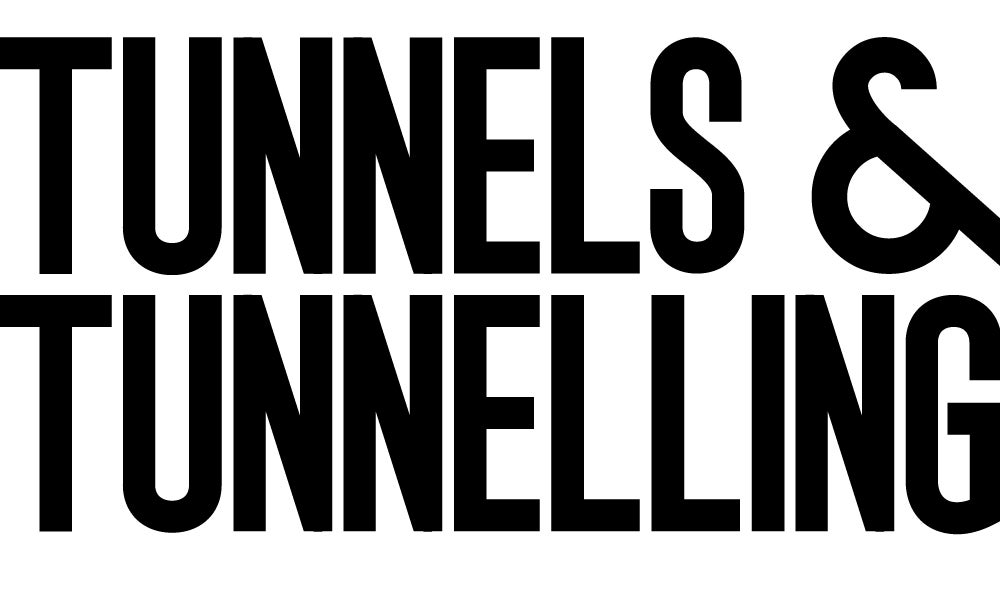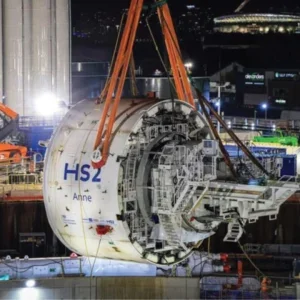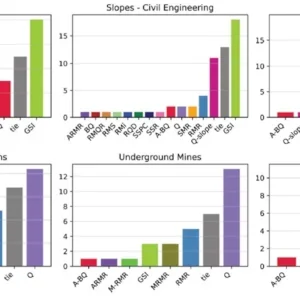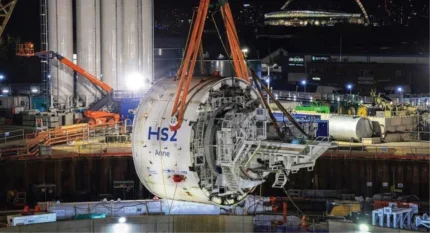
From Saint Barbara of the 16th Century, remembered in a statue at many tunnel portals, to Janet Bonnema’s 1972 walk‑on that ended a U.S. ban on women underground, the story of tunnelling has always been entwined with women’s presence—sometimes celebrated, often resisted. This article traces that arc from past superstition and legislation through to today’s data‑driven realities: a workforce that is still less than 12 % female; a sector‑leading 23 % gender‑pay gap in construction; and, the everyday biases that keep senior roles stubbornly male.
But it is also a record of change already under way. This article shows how the BTS Young Members’ (BTSYM) new Diversity, Inclusion & Women in Tunnelling subgroup is turning good intentions into measurable action, how properly fitting PPE and visible mentors are chipping away at structural barriers, and why initiatives such as celebrating International Women’s Day and our living IWD collage are amplifying women’s stories.
Finally, we look ahead. Drawing on industry research and voices like Christina Trigle, NCE Young Tunneller of the Year 2023 , and Anna Hayes, SCS’ Head of Technical Interface on HS2, we outline the innovation dividend that diversity brings, the flexible‑working and outreach moves needed to attract the next generation, and the steps every reader can take tomorrow.
Past, present and future: the following sets out where women in tunnelling have come from, what we are reshaping right now, and how an inclusive underground industry will better serve the world above.
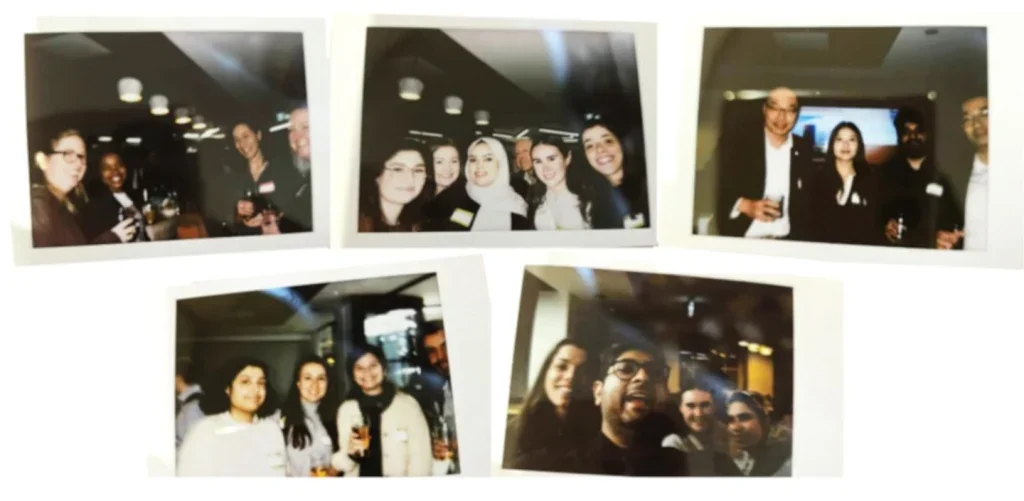
PAST
Whether one likes it or not women have heavily featured, positively or negatively, in tunnelling throughout history.
Positively as protectors represented by Saint Barbara and all the TBMs that have been named after notable women; and, negatively as historical superstitions held that having females working inside tunnels brought bad luck.
It is unclear when or where the tradition of naming the TBMs after relevant women started, or which TBM was the first, one but this ritual got hold quickly around the world. From the late 20th Century and now firmly into the 21st, local pools are organised in communities and schools to name the female mathematicians, Nobel prize winners, princesses, queens, and even local female teachers who would be chunking the ground, and in their own way, protecting those working inside the machines.
The protective function seems to be somehow related to Saint Barbara, who became the Saint patron of miners as far back as the 16th Century. According to legend, Barbara was imprisoned by her father for converting to Christianity. After she escaped, she hid in a rocky cliff that miraculously opened to shelter her. Her dramatic story was considered a sign of resilience, making her a fitting symbol for those working in dangerous conditions underground.
Saint Barbara, celebrated on 4th December every year, now presides upon tunnel projects in the Christian World from a shrine at a tunnel portal. This is often followed with a dedication and an invocation for protection of all who work on the project during the construction period.
Despite this tradition, it has also been clear, to those of us working in the trade from the beginning of our careers, that the industry has been surrounded with a deep rooted superstition: the belief that the presence of a woman in a mine or tunnel is bad luck. The belief could be seen even during the 20th Century in some countries, and when a group of women couldn’t tour a new bullet-train tunnel in Japan, in 2001.
Several explanations tried to justify this belief such as the fact that women only descended into mines in times of tragedy or that Saint Barbara is a jealous lady and did not want to share her domain with any other women. This superstition was even more poignant if the woman had red hair, as even seeing a red-hair woman in your way to the mine was an especially bad omen, as she was considered a portent of imminent death.
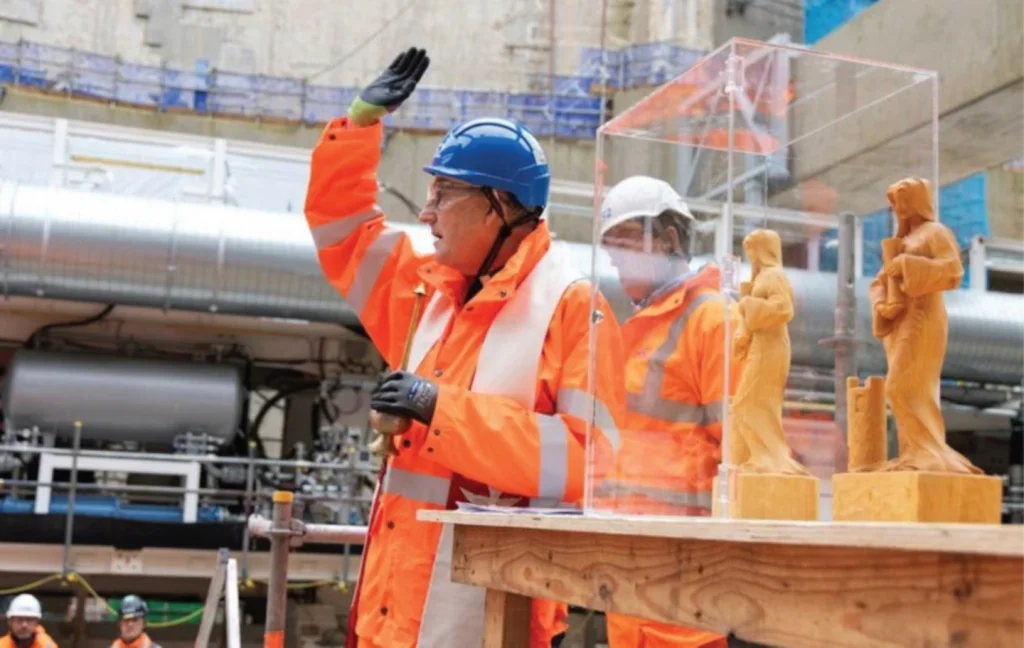
As late as in 1970, a tunnel official in the US told Life magazine that a tunnel was “no place for a woman.” Aside from not wanting women to hear the bad language the men might use or see them relieving themselves wherever they were, there were questions over physical suitability and stamina.
In the UK, the Mines and Collieries Act 1842 prohibited females from working underground, aiming to keep them and also children away from labour exploitation and poor working conditions. The effects of the Act went international around 100 years ago.
This journey of conflicting protection and superstition was finally legally settled in the early 1970s – just over 50 years ago – after Janet P. Bonnema, who was offered a job with the Colorado Highway Department (CHD) but denied access to the tunnel for being a woman. She brought a challenge. The U.S. Department of Transportation ruled “after a year-long investigation that to bar a woman from the tunnel was to practice sex discrimination.” Yet the CHD refused to abide by the decision. Bonnema filed a lawsuit.
After Colorado’s voters approved an amendment to the State’s Constitution to guarantee equal rights for women (finally approved in 1973), CHD settled, and in November 1972, Bonnema, in coveralls and a hard hat, made her first walk into the tunnel, accompanied by reporters. More than 60 men walked off the job. Most miners returned to work the next day. She persevered. A week later her entrance to the tunnel became normal practice.
In 2012, Janet P. Bonnema was inducted into the Colorado Women’s Hall of Fame.
At the time Bonnema’s case made headlines, the British Tunnelling Society (BTS) was constituted here in the UK. The first female engineer to become Chair of the BTS was Kate Cooksey, over 2020-2022.
We are writing this now to celebrate that we are here, we are here to stay, and for our contribution underground and our voices to continue to be heard.
Rosa Diez
PRESENT
Our journey as women in construction has never been paved with ease or entitlement. Structural barriers, cultural norms, and persistent personal biases have long worked to keep women underrepresented in senior roles. Yet, here we are—thriving, leading, and transforming the industry—not because the system was designed to support us, but because we pushed forward regardless.
Tunnelling is a highly skilled and challenging field, but it remains one of the most male-dominated areas in construction. Women are also reshaping the UK tunnelling industry below the surface. But, as of 2024, women only make up just 14.7% of the UK construction workforce, with approximately 303,136 women employed compared to 1.76 million men. The BTS/ BTSYM membership sampling shows fewer than 12 % of UK tunnelling professionals identify as female, 52% of which are under 35. A slightly better figure is found among individual members under 35, where almost 28% identified as female.
In relation to the gender pay gap, the 2024 statutory returns show women at the UK’s ten biggest contractor companies are still paid 23 % less per hour on average than their male colleagues. This is the worst pay gap of all industries in the report. Within the last six years, since the gender-pay-gap reporting became mandatory, the big-contractor average has narrowed the pay gap from 27% to 23%. Based on this rate, it would take another two decades for our industry to catch up with the all-industry average.
We have had to overcome daily reminders that we don’t fit the mould: ideas repeated by male colleagues and suddenly accepted as brilliant; conversations prefaced with “let me just run you through the basics,” as though our credentials were somehow invisible. Many of us have confronted imposter syndrome not as a passing phase, but as a companion forged by years of subtle exclusion. The statistics reinforce this: according to a 2021 InnovateMR survey, 65% of professionals today suffer from imposter syndrome, 75% of female executives have experienced it, and over half of women aged 25–34 say they’re feeling it right now. But rather than be defined by it, we’ve learned to name it, challenge it, and grow in spite of it.

On site, the challenges can be sharper: limited female-only washrooms on night shifts; long rotations that collide with caring responsibilities and high childcare costs; or, the unspoken pressure to ‘fit in’ with banter sometimes veers into uncomfortable territory. John Mitchell Lecturer 2024, Yvonne Ainsworth, highlighted important areas of progress, such as the availability of properly fitting personal protective equipment (PPE) for women, including options designed for pregnancy. The progress we’ve carved out is real, and it’s ours. PPE now comes in sizes and shapes that acknowledge the diversity of women’s bodies— including maternity wear. This isn’t just about better gear; it’s a signal that we are seen and expected to be on site, to stay, and to lead.
Our progress within BTSYM
As part of the BTSYM’s committee, we have created a Diversity, Inclusion & Wwomen in Tunnelling (DI&WiT) subgroup to lead specific initiatives aimed at making everyone feel like an integral part of the Society and turn good intentions into tangible change. We wanted to focus on advocating for inclusivity and ensuring that underrepresented groups in tunnelling feel supported.
As the current chair of the BTSYM, I made it a priority this term to ensure that women are not just present but visible and influential. Today, the BTSYM committee is the most diverse in our history, and more than half of our sub‑committees are led by women.
This matters. Our committee writes agendas, selects award winners and mentors the next cohort; therefore, our perspective now guides future decisions and aids in making our industry more inclusive to all who want to be part of our community.
One of the early DI&WiT initiatives was organising the first celebration of International Women’s Day, held on 6 March, at the Institution of Civil Engineers (ICE) headquarters, as a joint event between the BTS and BTSYM.
We wanted to celebrate the achievements of women in the tunnelling industry and the event saw an impressive turnout and strong engagement. The event aimed to celebrate Women in Tunnelling. There were 50 people gathered of diverse ages and genders. The event was supported by a fantastic lecture by Ramboll and then followed a very insightful session of networking and mentorship. People from a variety of profiles and roles attended, from high school students to company directors, including women who have left the industry.
Also, one of the initiatives we launched is a living collage with photographs and one‑line quotes from women at every stage of their tunnelling journey. The artwork travels to conferences and grows every time someone emails their tile to btsym@britishtunnelling. com – help us keep it alive!
Anna Hayes shared a reflection for the IWD and it reminds us that visible role models don’t just inspire the next generation; they sustain those already in the trenches. Her story also echoes Maya Angelou’s words that adorn her college title: “Let me remind all women that we live longer and better lives when we have sisters we love, not necessarily born in our bloodline or of our race. Sisters.”
Anna shared:
“I wanted to share my inspirational story that started with my mum, Patricia Perry – wife, mother of four, nanny to eight grandchildren and a secondary-school teacher who doubled as a careers adviser.
“Being the youngest child and only girl, I was used to a male-dominated (and rather sexist) home, but Mum encouraged me to explore careers. Four of the five top options on the questionnaire turned out to be construction-related!
“Through her contacts I spoke with directors and managers to find out what a ‘quantity surveyor’ really was and, after completing my A-levels, I landed my first job with British Airports Authority. That launched me into a career of more than 35 years in construction – from site engineer to project management, business development, work winning and, today, leadership and mentoring.
“During my time in the industry Mum always had my back, proofreading important articles to catch my dyslexia slips and – crucially – cheering me on when I returned to work after having children.
“Mum passed away in January 2021 after suffering from dementia and losing her ability to read and write – a mighty blow. But I am surrounded by friends who are my sisters in every sense, and their support proves what happens when life, career and home overlap.
“I’m delighted that I had – and still have – so many sisters in my world.”
Alongside our activities at the ICE in London, we also went to speak at Harris Academy Bermondsey Girls School and participated in the ITA35 International Women’s Day Initiative.
The following is Christina Trigle’s advice, which she shared as part of our living collage. She has three observations from her time in construction and tunnelling. They are clear and concise and convey what we should focus on to be the best version of ourselves while supporting each other to grow together.
- Do what you enjoy and be yourself. There is at times a very macho idea of leadership in construction, although this is fortunately changing. If you bring your own personality and style to your work (dare I say femininity?), this is much more valuable and respected than forcing yourself to be the caricature of an aggressive pit boss.
- You will find wonderful friends and mentors within the industry. Make sure you keep in touch as you move on to new projects and no longer work together. Support networks are as important in your profession as your personal life and it’s inevitable that not everyone you work with will be fantastic!
- Although there have been few female role models for me in senior leadership positions so far, they have made such a difference. Wherever you are in your career, just by being visible in the tunnelling community, you make it seem like an accessible choice for other women.
Also, we received a poem by Nilima Rajpari, Assistant site engineer – Tunnels and shafts delivery unit:
A poem dedicated to all the women out there!!
Brick by brick, women shape the world,
Lifting the dreams, standing high.
With steady hands and a positive vision,
They aim the sky with strength and might
Steel and stone, they bend with grace,
Breaking obstacles, holding space.
In hard hats crowned, they pave the way,
Brave and fearless, here to stay
Arabel Vilas Serín
FUTURE
The future of the tunnelling industry is being reshaped by a growing commitment to equity, diversity, and inclusion (EDI). It is important to celebrate the people who make up our industry, embracing inclusive design principles, and taking bold steps to ensure regardless of gender, background, or ability, everyone has a place in the industry.
It has never been a secret that ingenuity, creativity and innovation are what is required to solve the biggest problems faced in the construction and civil engineering industry. Large-scale projects are often praised for the incredible original solutions that have been dreamt up. So how can we amplify this?
The British Consulting Group has reported a significant correlation between the diversity in management teams and overall innovation, which strongly suggests diversity helps us be more innovative. Companies with more diverse leadership earned 19% more of their revenue from innovation (BCG, 2018). This supports the notion that excellence thrives in diversity, the likelihood of finding top-tier talent is increased when you open the door to more people, which is why the representation of women in the industry is important. A more diverse workforce also expands the talent pool at a time when the industry is facing growing demand for skilled professionals.
The percentage of women in the UK working population currently stands at approximately 47%. However, only around 15% of those employed in tunnelling is made up of women. Can we meet our potential in innovation if we only recruit the same kind of people?
Within the BTSYM, one aim is to explore how diversity and inclusion can be reflected in design itself. From an engineering perspective, inclusivity makes us better at our jobs. There are powerful examples from around the world of construction that embraces local materials, cultural relevance, and environmental sustainability. The Makoko Floating School in Nigeria was built using locally sourced wood and bamboo to serve a water- based community in a way that is both functional and environmentally conscious. In Senegal, eco-villages made from clay and straw preserve traditional building methods while providing sustainable housing. These projects remind us that inclusive design is also about empathy and respect for the people who use the spaces we build.
As we look to the future of tunnelling, the same principles of inclusivity and innovation can be understood. Just as diverse, locally informed design in construction results in more accessible and sustainable outcomes, so can a more inclusive approach to tunnelling. By empowering more women to influence the field, we welcome innovative ideas and solutions that reflect the diversity of the world we live in.
Women and girls tend to suffer more when impacted by climate change events such as flooding. Women around the world are also reported to have experienced many cases of sexual harassment on public transport. From a national UK poll, it was reported that 64% women of all ages had experienced sexual harassment in public places. As reported by the ICE, infrastructure is put in place with the intention to stay for decades which means undertaking works that ignore the needs of women can reinforce inequality for a very long period. Therefore, it makes sense to make women part of the decision-makers of their future life in and around public spaces.
The need to spotlight women in the industry may be obvious to some, but others question the need for this. The truth is, we shouldn’t have to, but we still do. The goal is to reach a point where these conversations are no longer necessary because equity has been achieved. Until then, we will keep moving forward. The theme of this year’s International Women’s Day celebration was to ‘Accelerate Action’. If you’re tired of hearing about inequality, then help to fix it.
What can be done? Too often, misogynistic and sexist behaviours are ignored or dismissed as normal. If you’re in a leadership position, you have a responsibility to call it out. Pay attention to how people treat one another. Understand that some team members may face challenges others don’t, simply because of their gender. As members of the tunnelling industry, we have a duty not only to share knowledge but to create a culture of respect and accountability.
An additional few ways we can all make a difference has also been highlighted by Katherine Evans, who has a networking initiative Bold as Brass. She says, practical actions can make an actual difference, including: giving credit in real time when a woman shares an idea; ensure PPE options are available to fit everyone; that sanitary bins are available underground; and, that rotas accommodate care responsibilities. Also, rotate meeting chairs to normalise diverse leadership styles; track data on promotion, retention, and pay by gender to focus efforts where they’re needed.
Evans also emphasises the importance of celebrating loudly! Nominating women for awards, inviting them to speak, and showcasing their contributions.
Flexible working can achieve good retention of female employees and is another area where the industry must evolve.
Despite some progress, construction remains one of the least flexible sectors, and this has a direct impact on gender equity. While the number of women in construction has grown over the past decade, the sector still struggles with rigid schedules, daily discrimination, and a persistent gender pay gap as previously mentioned. Embracing flexible working arrangements may become a necessity. It’s how tunnelling will need to compete with other sectors by attracting young talent, retaining the women already employed, and creating a more inclusive and supportive environment for everyone.
Gender bias and cognitive bias are significant blockers to the gender gap in the tunnelling industry. An experimental study has shown that that when evaluating the identical applications submitted as men and women, male applicants were viewed as more ‘hirable’.
Additionally, the ‘gender-confidence’ gap describes the reported difference in self-confidence in maths and science subjects between boys and girls. A poll undertaken by Teach First, a UK-based educational charity, has shown that out of the 30% of pupils who said they did not enjoy learning science at school, 43% of girls said they did not feel confident in the subject compared to a starkly different 26% of boys. These figures show that the gender gap in the STEM and subsequently, the tunnelling industry, is a problem that needs to be addressed at the early stages of education.
Government Events reported on 5 key reasons that affect women and girls choosing a career in Science, Technology, Engineering and Mathematics (STEM):
- Prior attainment in the subject
- Enjoyment of the subject
- Perceived competence at the subject
- Interest in the subject
- Awareness of the utility of the subject
The main themes to take away here are perceived self-competency and awareness. Visibility of women in the industry can tackle both these issues. Teach First is calling for high-quality teachers to inspire and encourage the next generation of STEM professionals. However, for non-teaching members of the tunnelling community, mentoring and outreach can help to solve the problem. Young women and girls are more likely to see themselves as competent in a career or subject when they can see role models that reflect themselves, ‘if she can do it, I can too’. Retention of women in the industry can also be linked with attraction of young female talent. Women enjoying successful tunnelling careers is attractive for other young women.
Recent research has also summarised that early exposure to STEM education can support the challenging of gender stereotypes. Education and mentorship are critical to sustaining this. Outreach programs and scholarships are encouraging young girls to pursue STEM careers in tunnelling and underground engineering. Mentorship from experienced professionals, especially women, provide guidance and awareness of the careers and roles available to young women in the tunnelling and construction industry.
Although change needs to occur at an accelerated rate to see gender equity in our lifetimes, there are a few groups already taking action that can be an inspiration to others for creating a brighter future for our industry.
At Aecom, almost 50% of the graduate intake in 2023 were women. They have also reported on pushing to create a more inclusive and flexible workplace in terms of parental leave.
The BTSYM intends to continue creating visibility of women in the team and by applauding women’s voices, providing opportunities for connection as well as organising knowledge sharing events delivered by women and open to all.
The ICE has just recently welcomed their youngest woman fellow, Georgia Thompson, who is also their youngest fellow in general. Additionally, the Women in Engineering Society is a women-focussed group who have provided work experience opportunities for female students as well as networking and social events for women in engineering.
Girls Under Construction aims to provide important connections and provide networking events to create a construction network specifically targeted at young women from a BAME background.
We devote time to construction and tunnelling in efforts to improve the status quo of the built environment to be used by everyone, from all walks of life. It makes sense, then, to involve everyone to have a say in the world around them that clearly influences and impacts our daily lives so greatly.
Tasnia Khanom
REFERENCES
- ‘Women’s History Month: Boring women’. (2022) The Brunel Museum, 1 March 2022. https://thebrunelmuseum.com/news/
- ‘Janet P. Bonnema: Women – bad luck?’. US Dept of Transportation, Federal Highway Administration (FHA). https://highways.dot.gov/highway-history/general-highway-history/janet-p-bonnemawomen-bad-luck
REFERENCES
- ‘Women in construction: Striving for equality on site (2025). https://www.geplus.co.uk/features/women-in-the-construction-industry-04-03-2025/
- ICE data, May 2025
- ‘Gender pay gap: biggest construction firms make slow but steady progress’ (08/04/2024) https://constructionmanagement.co.uk/gender-pay-gapbiggest-construction-firms-make-slow-butsteady-progress
- ‘Breaking ground and barriers’ (2024): Women in ground engineering and the imposter syndrome. https://www.geplus.co.uk/opinion/breakingground- and-barriers-28-02-2024/
REFERENCES
- ‘ https://stopstreetharassment.org/2016/03/uknationshstudy/
- ‘Francis-Devine, B., Zaidi, K. & Murray, A. (2025) ‘Women and the UK economy, House of Commons Library’. At: https://researchbriefings.files.parliament.uk/documents/SN06838/SN06838.pdf
- ‘Government Events. (2021) ‘Increasing female students’ uptake of STEM’ At: https://www.governmentevents.co.uk/increasing-femalestudents-uptake-of-stem/
- ‘Lorenzo, R. et al. (2018) ‘How diverse leadership teams boost innovation’. BCG Global. At: https://www.bcg.com/publications/2018/how-diverseleadership-teams-boost-innovation
- ‘Powell, A. & Francis-Fevine, B. (2025) ‘UK labour market statistics’ House of Commons Library. At: https://commonslibrary.parliament.uk/researchbriefings/cbp-9366/
